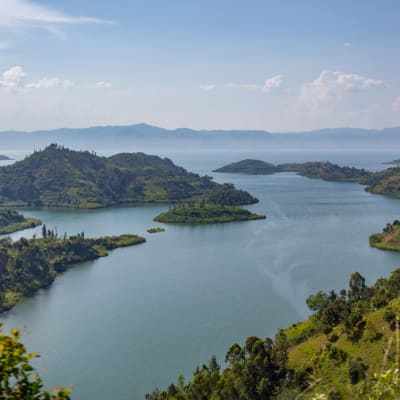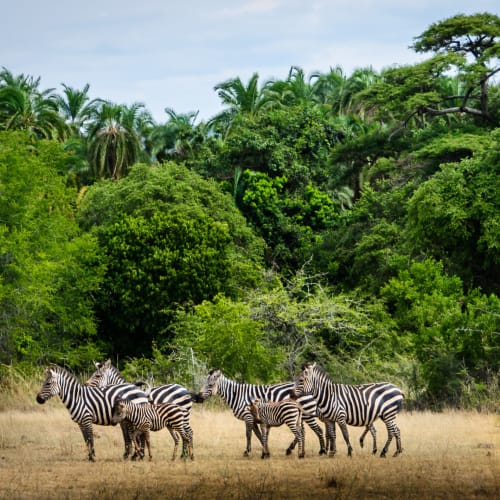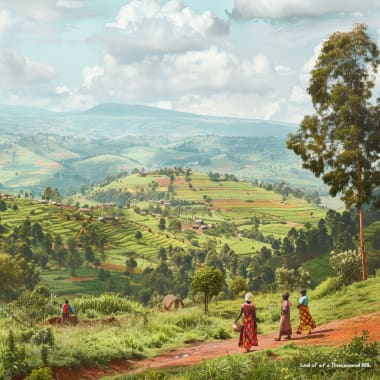
Rwanda's attractions
A journey through history and nature
A journey through history and nature
Rwanda is one of the most diverse travel destinations in Africa. In a small area, the country combines impressive natural wonders, moving historical sites, and a vibrant cultural scene. From the misty forests of Volcanoes National Park to the savannahs of Akagera National Park to the peaceful shores of Lake Kivu, each region offers its own unique experience. Culturally, Rwanda has much to tell – for instance, at the Kigali Genocide Memorial or the King’s Palace Museum in Nyanza.
In this article, we present five of the most remarkable sights in Rwanda that you should not miss on a Rwanda trip.
Overview of the main attractions in Rwanda
| Attraction | |
|---|---|
| Volcanoes National Park | • Home to the mountain gorillas and part of the Virunga mountain range |
| Kigali Genocide Memorial | • Most significant memorial in Rwanda, central to the country's history |
| Akagera National Park | • Only savannah park in Rwanda with the Big Five |
| Lake Kivu | • One of the most beautiful lakes in East Africa, ideal for relaxing |
| King’s Palace Museum, Nyanza | • Insight into the history of the Rwandan monarchy |
Volcanoes National Park
The Volcanoes National Park, also known as Parc National des Volcans, is located in the northwest of Rwanda, on the border with the Democratic Republic of Congo and Uganda. Covering an area of about 130 km², it is home to five of the eight Virunga volcanoes: Bisoke, Gahinga, Karisimbi, Muhabura, and Sabinyo. The park's landscape is characterized by dense tropical mountain forests, bamboo groves, and afro-alpine vegetation at higher altitudes, ranging from about 2,400 to over 4,000 meters.
As one of Rwanda's most significant destinations, Volcanoes National Park plays a central role in the country's tourism, primarily through the world-famous gorilla trekking. This unique experience has made Rwanda's tourism sector a crucial driver of the economy, with annual total revenues from tourism exceeding 400 million USD. The park is considered a showcase project for sustainable, high-end ecotourism that serves both conservation and economic development.
History
The mountain gorillas, which live in Volcanoes National Park, are not only a flagship of conservation but also have immense cultural significance for Rwanda. Since the 1980s, the population of this endangered species has grown from fewer than 300 to over 1,000 animals, which is celebrated as a major success in global species conservation. These successes have also transformed the lives of the local population: former poachers now work in gorilla tourism and benefit from the protection of the animals.
Internationally, the mountain gorillas gained fame through American primatologist Dian Fossey, who founded the Karisoke Research Center in 1967 and dedicated her life to protecting these animals. Her book 'Gorillas in the Mist' and the film of the same name made the gorillas world-famous. Historical events such as the founding of Albert National Park in 1925 – the predecessor of today's park – underline the long history of conservation in this region. Today, Rwanda's gorilla tourism serves as an example of the successful application of sustainable tourism for the preservation of endangered species.
Attractions and Activities
Volcanoes National Park offers a variety of experiences for its visitors. The main attraction is gorilla trekking, where you can observe the rare mountain gorillas in their natural habitat – a unique opportunity only available in a few places worldwide. However, other animals such as rare golden monkeys, bushbucks, or forest elephants can also be spotted in the park. The diverse birdlife, including 29 endemic species from the Virunga region, makes the park a paradise for ornithologists.
Besides trekking to the gorillas, volcano hikes are also a highlight. In particular, climbing the Bisoke volcano with its crater lake at the summit attracts many visitors. The 'Gorilla Guardians Village' also offers cultural experiences where travelers can learn about traditional dances and ceremonies of the local people.
The best travel time for gorilla trekking is during the dry seasons from June to September and December to February, while birdwatchers will find good opportunities from December to February when migratory birds winter in the park. Thus, Volcanoes National Park combines impressive nature experiences with cultural exchange and serves as a role model for sustainable tourism.
Kigali Genocide Memorial
The Kigali Genocide Memorial is one of the most significant memorials in Rwanda, dedicated to the memory of the victims of the genocide of 1994. It is located in the Gisozi neighborhood, about 3 kilometers northwest of Kigali's city center and is easily accessible within 10 to 15 minutes by car or taxi. The memorial is situated on a hill, offering a wide view over the city, emphasizing its symbolic significance.
Every year, tens of thousands of people visit this memorial, which not only serves as a historical landmark but also as an educational center. Visitors include international tourists, Rwandan students, and notable political figures. Since its opening in 2004, the memorial has played a central role in the national reflection on the genocide and contributes to the social and cultural identity of the country. It is a place of mourning, remembrance, and reconciliation for Rwanda.
History
The Kigali Genocide Memorial was opened in April 2004, on the 10th anniversary of the genocide against the Tutsis. The site has special historical significance, as it contains over 250,000 victims of the genocide buried in mass graves. The construction of the memorial was initiated by the British NGO Aegis Trust in collaboration with the Rwandan authorities.
The memorial addresses the horrific events of the genocide while also serving as a platform for education and reconciliation. Permanent exhibitions inform about Rwanda's history before, during, and after the genocide and also cover other genocides in world history. In addition, the memorial supports important educational programs that promote peace education and have been integrated into the national curriculum. Thus, the Kigali Genocide Memorial has become a central place of remembrance and learning for future generations and significantly contributes to national reconciliation.
Attractions and Activities
The Kigali Genocide Memorial offers visitors a variety of exhibitions and activities that help to understand the events of the genocide. Three permanent exhibitions document the genocide against the Tutsis, the child victims of the genocide, and other genocides of the 20th century, including the Holocaust. Besides the exhibitions, visitors can explore the memorial gardens and the mass graves where 250,000 victims found their final resting place. A special highlight is the children's memorial dedicated to the youngest victims of the genocide.
Every year on April 7th, a national memorial ceremony is held at the memorial to commemorate the anniversary of the genocide. Additionally, the 'Ubumuntu Arts Festival' is held in the memorial's amphitheater, promoting reconciliation through art. Visitors can participate in guided tours, often led by genocide survivors, or explore the exhibitions individually with an audio guide. The memorial also offers educational programs specifically designed for students and international visitors, and the Genocide Archive of Rwanda, which preserves testimonies and artifacts, is also part of the memorial.
With these diverse offerings, the Kigali Genocide Memorial is not just a memorial but also a significant educational center that addresses the history of the genocide and fosters empathy and understanding.
Akagera National Park
The Akagera National Park is the only savannah national park in Rwanda and is located in the eastern part of the country, on the border with Tanzania. Covering an area of 1,122 km², the park features an impressive diversity of landscapes, including open savannahs, forested areas, swamps, and lakes such as Lake Ihema. About a third of the park consists of wetlands, making Akagera the largest protected wetland in East Africa. The park is particularly known for the 'Big Five' – lion, leopard, elephant, rhinoceros, and buffalo – and is the only place in Rwanda where visitors can observe these famous animals. Through successful reintroduction projects, such as the introduction of lions in 2015 and rhinoceroses in subsequent years, Akagera has developed into an important conservation area and tourist hotspot. In 2018, the park recorded approximately 44,000 visitors, making it a significant part of Rwanda's tourism industry.
History
Akagera National Park was established in 1934 by the Belgian colonial administration and was initially twice as large as it is today. After the genocide in 1994, the park was significantly reduced in size as returning refugees were settled in the region. This led to serious issues from poaching and the loss of key species such as lions and rhinoceroses. However, in 2010, the organization African Parks took over management of the park in collaboration with the Rwandan government and initiated extensive conservation measures. A 120-kilometer electric fence was constructed to reduce human-wildlife conflicts, and a specialized anti-poaching unit was established. Through the reintroduction of lions and rhinoceroses, Akagera is now the only protected area in Rwanda where all the 'Big Five' are present. In addition to species conservation, the local population benefits from educational and employment programs as well as a share of tourism revenues, which has strengthened the acceptance of the park.
Attractions and Activities
Visitors to Akagera National Park can enjoy a variety of activities. Safari tours are particularly popular, taking place both early in the morning and in the evening to provide the best chances of animal sightings. Boat tours on Lake Ihema also allow for observing hippos, crocodiles, and a variety of waterbirds. For those seeking a unique experience, a night safari is available, where nocturnal animals such as hyenas and leopards are spotted with spotlights. The park is also a paradise for bird watchers, with over 500 bird species including the rare Shoebill. For adventure seekers, the park also offers fishing trips on the lakes. The best times for wildlife observations are the dry seasons from June to September and December to February when animals gather at watering holes. However, special experiences are also possible during the rainy seasons, especially for bird watchers, as many migratory birds come to the park then.
Akagera National Park offers impressive experiences year-round amidst breathtaking landscapes that excite both nature lovers and adventurers.
Lake Kivu
Lake Kivu, which stretches along the border between Rwanda and the Democratic Republic of Congo, is truly a unique body of water in central Africa. Part of the Albertine Rift, a branch of the East African Rift System, Lake Kivu with its 2,700 km² is one of the largest and deepest lakes in Africa, with a maximum depth of up to 480 meters. Nestled in a spectacular landscape at an altitude of 1,460 meters above sea level, the lake is increasingly attracting tourists seeking relaxation amidst stunning nature. Whether swimming, boating, or relaxing on picturesque beaches, Lake Kivu offers a variety of recreational opportunities. At the same time, the lake plays an important role in the local economy, particularly through fishing and trade between Rwanda and the DR Congo.
History
Lake Kivu has not only a geographical, but also a significant historical and cultural role in the region. In 1894, the lake was first mapped for Europe by the German explorer Count Adolf von Götzen, but its significance reaches far back into the past. Unfortunately, Lake Kivu also played a dark role during the Rwandan genocide in 1994 when it was used to dispose of many victims. The local communities around the lake have traditionally lived off fishing, particularly night fishing for Sambaza, a sardine-like fish species. Additionally, legends surround the lake, telling mystical stories about ghosts and demons associated with the occasional gas eruptions of the lake.
In recent years, tourism at Lake Kivu has developed significantly, with numerous hotels, resorts, and infrastructures emerging. From boat tours to the islands to relaxing on the beaches, Lake Kivu is now a popular stop for tourists on their way to Rwanda’s national parks.
Attractions and Activities
At Lake Kivu, a variety of activities await nature and culture enthusiasts. Boat tours are among the most popular experiences, allowing visitors to explore the calm expanse of the lake and visit islands such as Amahoro and Napoleon Island. Swimming is also a highlight, as the lake is free from bilharzia, making it one of the few African lakes ideal for swimming. Water sports such as kayaking, jet skiing, windsurfing, and stand-up paddling are also widespread.
For nature lovers, Lake Kivu offers hikes along the Congo Nile Trails, birdwatching, or visiting islands like Napoleon Island with its famous bat colony. Cultural experiences are also available: the region is known for traditional fishing villages and markets that provide insights into local life. Another highlight are the hot springs near the lake, promising relaxation and a unique nature experience. The best travel time for Lake Kivu is from June to September and December to February when the weather is ideal for outdoor activities. Lake Kivu is a place where adventure, nature, and relaxation come together in perfect harmony.
King’s Palace Museum in Nyanza
The King’s Palace Museum in Nyanza, in southern Rwanda, about 88 kilometers from Kigali, is an important cultural center of the country. Nestled in a picturesque, hilly landscape, the museum offers deep insights into the history of the Rwandan monarchy. Nyanza was the political and administrative center of Rwanda until the abolition of the monarchy in 1961 and served as the residence of Rwandan kings, the Mwami. The museum is now a prominent destination for cultural tourists, who stop there on their way to Nyungwe Forest National Park to learn more about Rwanda's royal past. It plays a central role in preserving the history of the monarchy and offers visitors the chance to explore an authentic reconstruction of the traditional royal palace as well as the modern palace from the colonial period.
History
The historical significance of the King’s Palace Museum dates back to the late 19th century when Nyanza became the permanent seat of the Rwandan royal court. King Yuhi V Musinga built his palace here in 1899 to gain prestige in front of colonial powers. Until the abolition of the monarchy in 1961, the palace served as the residence of Rwandan kings. Visitors can today see both a replica of the traditional palace and the modern palace of King Mutara III. Rudahigwa, who lived in a palace made of clay and thatch until 1931 before moving into a European-style palace.
A special highlight of the museum is the Inyambo cattle, which played a ceremonial role in the monarchy. These long-horned cows were richly adorned and took part in royal processions. Their keepers still maintain the tradition of singing to the animals and training them, bringing back the royal ceremonies of the past.
Attractions and Activities
The King’s Palace Museum offers an impressive blend of historical exhibits and interactive experiences. The replica of the traditional palace, complete with thatched roofs and clay walls, transports visitors to the architecture of past times. In the modern palace from the 1930s, the king’s original furniture and personal items are on display. A special highlight is the herd of Inyambo cattle, descendants of the royal herd, which visitors can experience up close.
In addition to the architecture and exhibits, the museum offers cultural performances showcasing traditional dances, drumming, and crafts. Guided tours with knowledgeable guides provide deeper insights into the history and culture of the monarchy. The museum also offers special educational programs for schools and groups with interactive workshops and live demonstrations of the cattle.
With this unique combination of historical buildings, royal artifacts, and vibrant traditions, the King’s Palace Museum allows visitors to immerse themselves in the history of the Rwandan monarchy while experiencing the cultural roots of the country.
An unforgettable journey of discovery
Rwanda's attractions offer a wide range of experiences that reflect the country in all its diversity. Whether trekking in the mountains of Volcanoes National Park following the trails of the mountain gorillas or diving into the royal past at the King’s Palace Museum in Nyanza – each place has its own charm and conveys unique impressions of Rwanda's rich natural and cultural heritage. Plan your trip to these extraordinary destinations and let yourself be inspired by the beauty and depth of this fascinating country.
Experience the magic of Africa with experts who have explored every corner themselves
Your dream holiday, tailor-made by experts.
Our travel consultants not only admire Africa from afar, but also explore the most impressive regions every year to experience the cultures, landscapes and experiences, such as gorilla trekking, at first hand.
From your first enquiry to your return home, we are there for you personally - by phone, email or WhatsApp, whenever you need us. Immerse yourself in the world of gorillas, experience the beauty of Africa and create memories that will last a lifetime. Let's create your next great adventure together!
Experts for your Africa trip
















